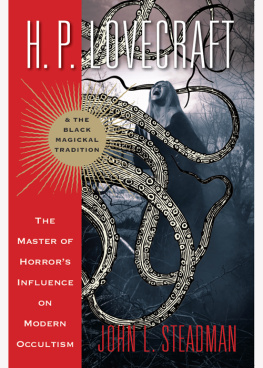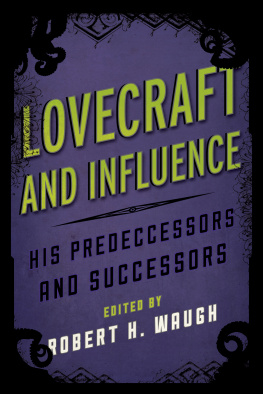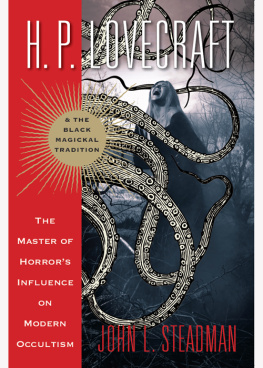Howard Lovecraft - The Whisperer in Darkness
Here you can read online Howard Lovecraft - The Whisperer in Darkness full text of the book (entire story) in english for free. Download pdf and epub, get meaning, cover and reviews about this ebook. genre: Science fiction. Description of the work, (preface) as well as reviews are available. Best literature library LitArk.com created for fans of good reading and offers a wide selection of genres:
Romance novel
Science fiction
Adventure
Detective
Science
History
Home and family
Prose
Art
Politics
Computer
Non-fiction
Religion
Business
Children
Humor
Choose a favorite category and find really read worthwhile books. Enjoy immersion in the world of imagination, feel the emotions of the characters or learn something new for yourself, make an fascinating discovery.

- Book:The Whisperer in Darkness
- Author:
- Genre:
- Rating:3 / 5
- Favourites:Add to favourites
- Your mark:
- 60
- 1
- 2
- 3
- 4
- 5
The Whisperer in Darkness: summary, description and annotation
We offer to read an annotation, description, summary or preface (depends on what the author of the book "The Whisperer in Darkness" wrote himself). If you haven't found the necessary information about the book — write in the comments, we will try to find it.
The Whisperer in Darkness — read online for free the complete book (whole text) full work
Below is the text of the book, divided by pages. System saving the place of the last page read, allows you to conveniently read the book "The Whisperer in Darkness" online for free, without having to search again every time where you left off. Put a bookmark, and you can go to the page where you finished reading at any time.
Font size:
Interval:
Bookmark:
The Whisperer in Darkness
by Howard Phillips Lovecraft
Chapter 1
Bear in mind closely that I did not see any actual visual horror at the end. To say that a mental shock was the cause of what I inferred that last straw which sent me racing out of the lonely Akeley farmhouse and through the wild domed hills of Vermont in a commandeered motor at night is to ignore the plainest facts of my final experience. Notwithstanding the deep things I saw and heard, and the admitted vividness the impression produced on me by these things, I cannot prove even now whether I was right or wrong in my hideous inference. For after all Akeley's disappearance establishes nothing. People found nothing amiss in his house despite the bullet-marks on the outside and inside. It was just as though he had walked out casually for a ramble in the hills and failed to return. There was not even a sign that a guest had been there, or that those horrible cylinders and machines had been stored in the study. That he had mortally feared the crowded green hills and endless trickle of brooks among which he had been born and reared, means nothing at all, either; for thousands are subject to just such morbid fears. Eccentricity, moreover, could easily account for his strange acts and apprehensions toward the last.
The whole matter began, so far as I am concerned, with the historic and unprecedented Vermont floods of November 3, 1927. I was then, as now, an instructor of literature at Miskatonic University in Arkham , Massachusetts , and an enthusiastic amateur student of New England folklore. Shortly after the flood, amidst the varied reports of hardship, suffering, and organized relief which filled the press, there appeared certain odd stories of things found floating in some of the swollen rivers; so that many of my friends embarked on curious discussions and appealed to me to shed what light I could on the subject. I felt flattered at having my folklore study taken so seriously, and did what I could to belittle the wild, vague tales which seemed so clearly an outgrowth of old rustic superstitions. It amused me to find several persons of education who insisted that some stratum of obscure, distorted fact might underlie the rumors.
The tales thus brought to my notice came mostly through newspaper cuttings; though one yarn had an oral source and was repeated to a friend of mine in a letter from his mother in Hardwick , Vermont . The type of thing described was essentially the same in all cases, though there seemed to be three separate instances involved one connected with the Winooski River near Montpelier , another attached to the West River in Windham County beyond Newfane, and a third centering in the Passumpsic in Caledonia County above Lyndonville. Of course many of the stray items mentioned other instances, but on analysis they all seemed to boil down to these three. In each case country folk reported seeing one or more very bizarre and disturbing objects in the surging waters that poured down from the unfrequented hills, and there was a widespread tendency to connect these sights with a primitive, half-forgotten cycle of whispered legend which old people resurrected for the occasion.
What people thought they saw were organic shapes not quite like any they had ever seen before. Naturally, there were many human bodies washed along by the streams in that tragic period; but those who described these strange shapes felt quite sure that they were not human, despite some superficial resemblances in size and general outline. Nor, said the witnesses, could they have been any kind of animal known to Vermont . They were pinkish things about five feet long; with crustaceous bodies bearing vast pairs of dorsal fins or membranous wings and several sets of articulated limbs, and with a sort of convoluted ellipsoid, covered with multitudes of very short antennae, where a head would ordinarily be. It was really remarkable how closely the reports from different sources tended to coincide; though the wonder was lessened by the fact that the old legends, shared at one time throughout the hill country, furnished a morbidly vivid picture which might well have coloured the imaginations of all the witnesses concerned. It was my conclusion that such witnesses in every case naive and simple backwoods folk had glimpsed the battered and bloated bodies of human beings or farm animals in the whirling currents; and had allowed the half-remembered folklore to invest these pitiful objects with fantastic attributes.
The ancient folklore, while cloudy, evasive, and largely forgotten by the present generation, was of a highly singular character, and obviously reflected the influence of still earlier Indian tales. I knew it well, though I had never been in Vermont , through the exceedingly rare monograph of Eli Davenport, which embraces material orally obtained prior to 1839 among the oldest people of the state. This material, moreover, closely coincided with tales which I had personally heard from elderly rustics in the mountains of New Hampshire . Briefly summarized, it hinted at a hidden race of monstrous beings which lurked somewhere among the remoter hills in the deep woods of the highest peaks, and the dark valleys where streams trickle from unknown sources. These beings were seldom glimpsed, but evidences of their presence were reported by those who had ventured farther than usual up the slopes of certain mountains or into certain deep, steep-sided gorges that even the wolves shunned.
There were queer footprints or claw-prints in the mud of brook-margins and barren patches, and curious circles of stones, with the grass around them worn away, which did not seem to have been placed or entirely shaped by Nature. There were, too, certain caves of problematical depth in the sides of the hills; with mouths closed by boulders in a manner scarcely accidental, and with more than an average quota of the queer prints leading both toward and away from them if indeed the direction of these prints could be justly estimated. And worst of all, there were the things which adventurous people had seen very rarely in the twilight of the remotest valleys and the dense perpendicular woods above the limits of normal hill-climbing.
It would have been less uncomfortable if the stray accounts of these things had not agreed so well. As it was, nearly all the rumors had several points in common; averring that the creatures were a sort of huge, light-red crab with many pairs of legs and with two great batlike wings in the middle of the back. They sometimes walked on all their legs, and sometimes on the hindmost pair only, using the others to convey large objects of indeterminate nature. On one occasion they were spied in considerable numbers, a detachment of them wading along a shallow woodland watercourse three abreast in evidently disciplined formation. Once a specimen was seen flying launching itself from the top of a bald, lonely hill at night and vanishing in the sky after its great flapping wings had been silhouetted an instant against the full moon.
These things seemed content, on the whole, to let mankind alone; though they were at times held responsible for the disappearance of venturesome individuals especially persons who built houses too close to certain valleys or too high up on certain mountains. Many localities came to be known as inadvisable to settle in, the feeling persisting long after the cause was forgotten. People would look up at some of the neighbouring mountain-precipices with a shudder, even when not recalling how many settlers had been lost, and how many farmhouses burnt to ashes, on the lower slopes of those grim, green sentinels.
But while according to the earliest legends the creatures would appear to have harmed only those trespassing on their privacy; there were later accounts of their curiosity respecting men, and of their attempts to establish secret outposts in the human world. There were tales of the queer claw-prints seen around farmhouse windows in the morning, and of occasional disappearances in regions outside the obviously haunted areas. Tales, besides, of buzzing voices in imitation of human speech which made surprising offers to lone travelers on roads and cart-paths in the deep woods, and of children frightened out of their wits by things seen or heard where the primal forest pressed close upon their door-yards. In the final layer of legends the layer just preceding the decline of superstition and the abandonment of close contact with the dreaded places there are shocked references to hermits and remote farmers who at some period of life appeared to have undergone a repellent mental change, and who were shunned and whispered about as mortals who had sold themselves to the strange beings. In one of the northeastern counties it seemed to be a fashion about 1800 to accuse eccentric and unpopular recluses of being allies or representatives of the abhorred things.
Font size:
Interval:
Bookmark:
Similar books «The Whisperer in Darkness»
Look at similar books to The Whisperer in Darkness. We have selected literature similar in name and meaning in the hope of providing readers with more options to find new, interesting, not yet read works.
Discussion, reviews of the book The Whisperer in Darkness and just readers' own opinions. Leave your comments, write what you think about the work, its meaning or the main characters. Specify what exactly you liked and what you didn't like, and why you think so.




